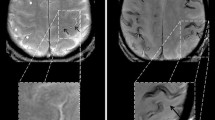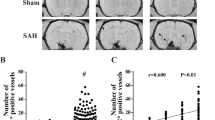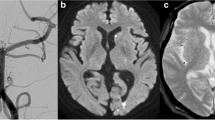Abstract
Introduction
It is still unclear how often subarachnoid hemorrhage (SAH) leads to chronic hemosiderin depositions. In this study, we aimed to determine the frequency of chronic hemosiderin depositions after aneurysmal SAH in patients who did not undergo surgery. Furthermore, we analyzed typical MRI patterns of chronic SAH and sought to obtain information on the temporal course of MRI signal changes.
Methods
We retrospectively analyzed 90 patients who had undergone endovascular treatment for acute aneurysmal SAH. In all patients, initial CT studies and at least one T2*-weighted MRI obtained 6 months or later after SAH were analyzed for the presence and anatomical distribution of SAH or chronic hemosiderin depositions. In total, 185 T2*-weighted MRI studies obtained between 2 days and 148 months after SAH were evaluated (mean follow-up 30.2 months).
Results
On MRI studies obtained later than 6 months after SAH, subpial hemosiderin depositions were found in 50 patients (55.5 %). Most frequent localizations were the parenchyma adjacent to the frontal and parietal sulci and the insular cisterns. While the appearance of hemosiderin depositions was dynamic within the first 3 months, no changes were found during subsequent follow-up. MR signal changes were not only conclusive with subarachnoid hemosiderin depositions but in many cases also resembled those that have been associated with cortical hemosiderosis.
Conclusions
T2*-weighted MRI is an effective means of diagnosing prior SAH. Our study suggests that chronic hemosiderin depositions can be found in a considerable number of patients after a single event of subarachnoid hemorrhage.




Similar content being viewed by others
References
Gomori JM, Grossman RI, Hackney DB, Goldberg HI, Zimmerman RA, Bilaniuk LT (1988) Variable appearances of subacute intracranial hematomas on high-field spin-echo MR. AJR Am J Roentgenol 150(1):171–178
Takada S, Inoue T, Niizuma K, Shimizu H, Tominaga T (2011) Hemosiderin detected by T2*-weighted magnetic resonance imaging in patients with unruptured cerebral aneurysms: indication of previous bleeding? Neurol Med Chir (Tokyo) 51(4):275–281
Horita Y, Imaizumi T, Hashimoto Y, Niwa J (2008) Subarachnoid hemosiderin deposition after subarachnoid hemorrhage on T2*-weighted MRI correlates with the location of disturbed cerebrospinal fluid flow on computed tomography cisternography. Neurol India 56(1):62–64
Toyama K, Imaizumi T, Yoshifuji K, Miyata K, Kawamura M, Kohama I (2005) Study on hemosiderin deposition after intracerebral hemorrhage. No Shinkei Geka 33(12):1177–1181
Inoue T, Takada S, Shimizu H et al (2013) Signal changes on T2*-weighted magnetic resonance imaging from the acute to chronic phases in patients with subarachnoid hemorrhage. Cerebrovasc Dis 36(5-6):421–429
Kinoshita T, Okudera T, Tamura H, Ogawa T, Hatazawa J (2000) Assessment of lacunar hemorrhage associated with hypertensive stroke by echo-planar gradient-echo T2*-weighted MRI. Stroke 31(7):1646–1650
Yuan MK, Lai PH, Chen JY et al (2005) Detection of subarachnoid hemorrhage at acute and subacute/chronic stages: comparison of four magnetic resonance imaging pulse sequences and computed tomography. J Chin Med Assoc 68(3):131–137
Wiesmann M, Mayer TE, Yousry I, Hamann GF, Brückmann H (2001) Detection of hyperacute parenchymal hemorrhage of the brain using echo-planar T2*-weighted and diffusion-weighted MRI. Eur Radiol 11(5):849–853
van Gijn J, van Dongen KJ (1982) The time course of aneurysmal haemorrhage on computed tomograms. Neuroradiology 23(3):153–156
Ito U, Inaba Y (1973) Cerebrospinal fluid cytology for detection of subarachnoid hemorrhage long after the attack and estimation of post-hemorrhagic duration. Rinsho Shinkeigaku 13(5):283–290
Imaizumi T, Chiba M, Honma T, Niwa J (2003) Detection of hemosiderin deposition by T2*-weighted MRI after subarachnoid hemorrhage. Stroke 34(7):1693–1698
Lummel N, Bernau C, Thon N, Bochmann K, Linn J (2015) Prevalence of superficial siderosis following singular, acute aneurysmal subarachnoid hemorrhage. Neuroradiology 57(4):349–356. doi:10.1007/s00234-014-1480-6
Teasdale GM, Drake CG, Hunt W, Kassell N, Sano K, Pertuiset B, De Villiers JC (1988) A universal subarachnoid hemorrhage scale: report of a committee of the World Federation of Neurosurgical Societies. J Neurol Neurosurg Psychiatry 51(11):1457
Fisher CM, Kistler JP, Davis JM (1980) Relation of cerebral vasospasm to subarachnoid hemorrhage. Neurosurgery 6(1):1–9
Linn J, Herms J, Dichgans M, Brückmann H, Fesl G, Freilinger T, Wiesmann M (2008) Subarachnoid hemosiderosis and superficial cortical hemosiderosis in cerebral amyloid angiopathy. AJNR Am J Neuroradiol 29(1):184–186
Kumar N (2010) Neuroimaging in superficial siderosis: an in-depth look. AJNR Am J Neuroradiol 31(1):5–14
Spitzer C, Mull M, Rohde V, Kosinski CM (2005) Non-traumatic cortical subarachnoid haemorrhage: diagnostic work-up and aetiological background. Neuroradiology 47:525–531
Kakeda S, Korogi Y, Ohnari N, Nishimura J, Moriya J et al (2010) Superficial siderosis associated with a chronic subdural hematoma: T2-weighted MR imaging at 3T. Acad Radiol 17:871–876. doi:10.1016/j.acra.2010.02.014
Zhao H, Wang J, Lu Z, Wu Q, Lv H, Liu H, Gong X (2015) Superficial siderosis of the central nervous system induced by a single-episode of traumatic subarachnoid hemorrhage: a study using MRI-enhanced gradient echo T2 star-weighted angiography. PLoS One 10(2):e0116632
Lummel N, Wollenweber FA, Demaerel P, Bochmann K, Malik R, Opherk C, Linn J (2015) Clinical spectrum, underlying etiologies and radiological characteristics of cortical superficial siderosis. J Neurol
Guo LF, Wang G, Zhu XY, Liu C, Cui L (2013) Comparison of ESWAN, SWI-SPGR, and 2D T2*-weighted GRE sequence for depicting cerebral microbleeds. Clin Neuroradiol 23(2):121–127
Yilmaz U, Körner H, Meyer S, Reith W (2014) Multifocal signal loss at bridging veins on susceptibility-weighted imaging in abusive head trauma. Clin Neuroradiol
Noguchi K, Ogawa T, Inugami A, Toyoshima H, Okudera T, Uemura K (1994) MR of acute subarachnoid hemorrhage: a preliminary report of fluid-attenuated inversion-recovery pulse sequences. AJNR Am J Neuroradiol 15(10):1940–1943
Noguchi K, Ogawa T, Seto H et al (1997) Subacute and chronic subarachnoid hemorrhage: diagnosis with fluid-attenuated inversion-recovery MR imaging. Radiology 203(1):257–262
Wiesmann M, Mayer TE, Medele R, Bruckmann H (1999) Diagnosis of acute subarachnoid hemorrhage at 1.5 Tesla using proton-density weighted FSE and MRI sequences. Radiologe 39(10):860–865
Wiesmann M, Mayer TE, Yousry I, Medele R, Hamann GF, Bruckmann H (2002) Detection of hyperacute subarachnoid hemorrhage of the brain by using magnetic resonance imaging. J Neurosurg 96(4):684–689
Lummel N, Wiesmann M, Brückmann H, Linn J (2010) The value of different magnetic resonance imaging sequences for the detection of intraventricular hemorrhages. Clin Neuroradiol 20(1):38–47
McCarron MO, McKinstry CS, Gibson JM (2002) Superficial siderosis 20 years after brain tumour. Lancet Neurol 1(5):326
Ethical standards and patient consent
We declare that all human and animal studies have been approved by the Ethics Committee of the Faculty of Medicine at RWTH Aachen University and have therefore been performed in accordance with the ethical standards laid down in the 1964 Declaration of Helsinki and its later amendments. We declare that all patients gave informed consent prior to inclusion in this study.
Conflict of interest
We declare that we have no conflict of interest.
Author information
Authors and Affiliations
Corresponding author
Rights and permissions
About this article
Cite this article
Falter, B., Wiesmann, M., Freiherr, J. et al. Frequency and appearance of hemosiderin depositions after aneurysmal subarachnoid hemorrhage treated by endovascular therapy. Neuroradiology 57, 999–1006 (2015). https://doi.org/10.1007/s00234-015-1559-8
Received:
Accepted:
Published:
Issue Date:
DOI: https://doi.org/10.1007/s00234-015-1559-8




